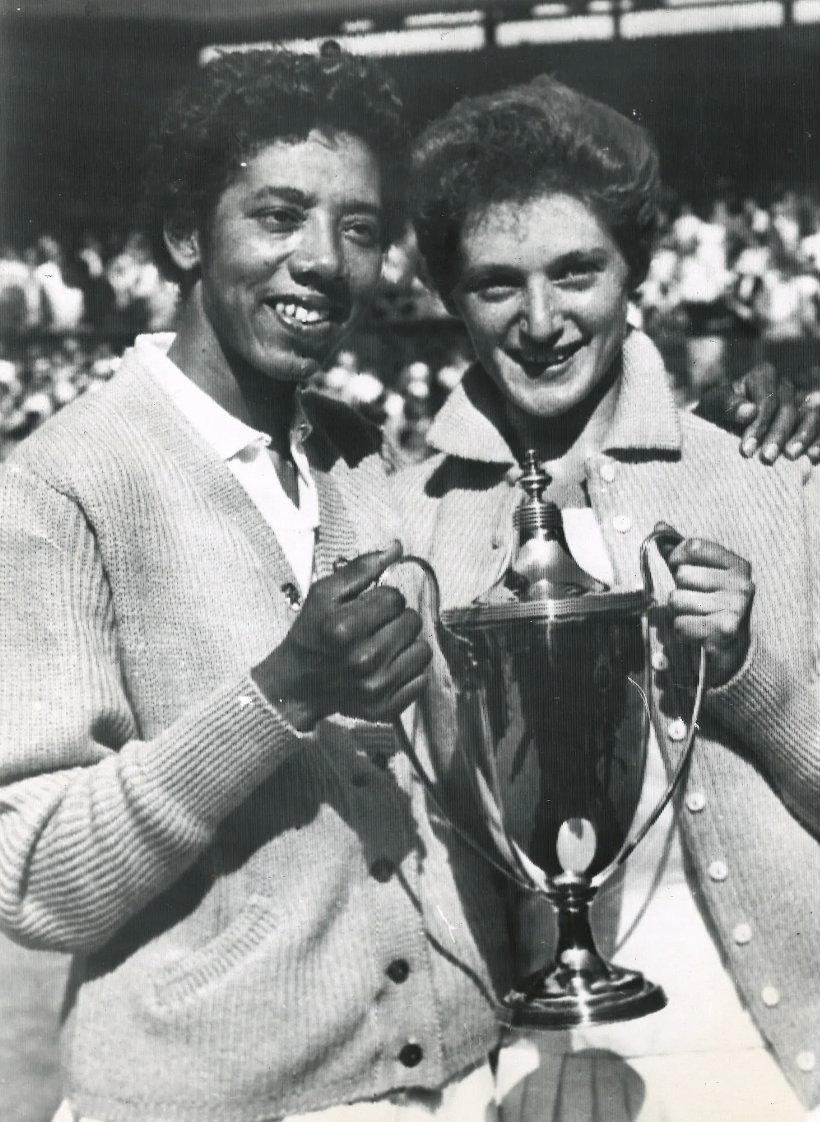Angela Buxton, long retired from tennis, yet still living a very busy life at her holiday home in Florida, received a disturbing phone call out of the blue one spring day in 1996 — just 40 years short of her greatest feat on tour. In an instant, she recognised the voice at the other end: Althea Gibson, Buxton’s old friend and doubles partner and the first Black woman to play in — and win — Wimbledon. Gibson needed help, she said — she needed money.
Buxton hadn’t heard from Gibson for possibly a decade, yet she jumped to attention, according to the 2002 book The Match, calling all their old tennis pals and alerting the United States Tennis Association (USTA). In the end, Buxton raised nearly $500,000 for Gibson to live comfortably until passed in 2003.
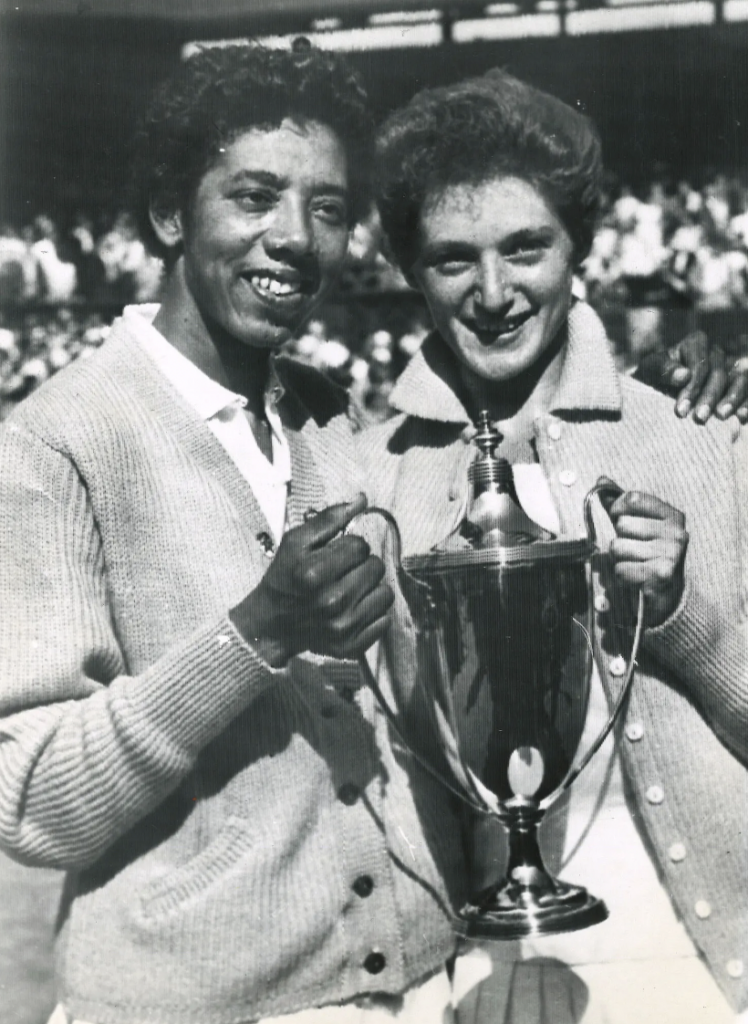
Tennis partners Althea Gibson, left, and Angela Buxton, hold the 1956 Wimbledon Ladies’ Doubles trophy. Buxton became one of the few English finalists that same year, losing to American Shirley Fry.
The act was typical for Buxton — the woman who said “yes” when everyone else said “no.” A justice warrior from an early age, she learned how to play tennis in apartheid South Africa, where she, her mother and her brother had been sent by her Jewish father during World War II. When Buxton returned to London post-War and was rejected by polite tennis society, she was equally determined to succeed, and in 1954, she earned the British No. 4 ranking, started playing Wightman Cup matches for England. Two years later, Buxton played the 1956 ladies singles Championship and won the doubles with Gibson.

Angela Buxton likely wearing one of her Lillywhite’s dresses in 1955, when she was ranked among the top 10 female players in the world.
Yet Buxton never received a membership at either the Cumberland Lawn Tennis Club — the North London club where she spent her formative years — or the All-England Lawn Tennis Club (AELTC), the host club of Wimbledon, neither while she was alive or posthumously. She was neither memorialised with a statue nor a scholarship, an induction into the International Tennis Hall of Fame (ITHF) in Rhode Island nor a special exhibit in any Jewish Museum, aside from the National Jewish Sports Hall of Fame and the Black Tennis Hall of Fame, “for her for her doubles partnership… as well as her efforts to raise funds for the ailing Gibson near the end of her life.”
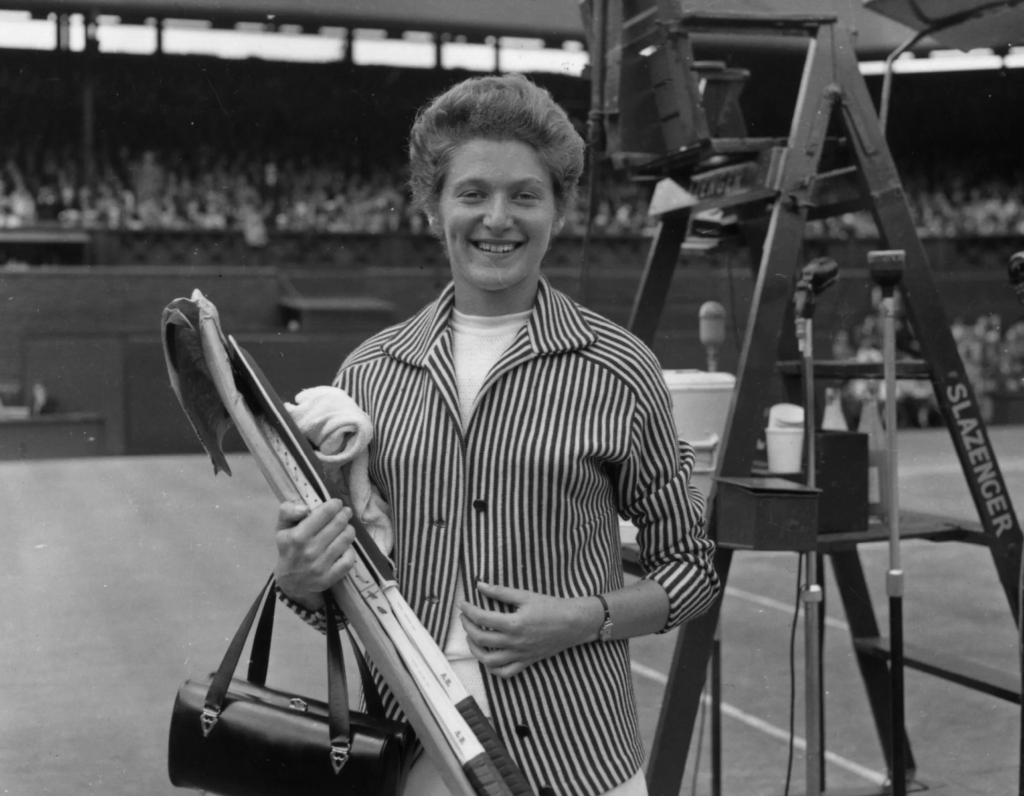
Angela Buxton in her later years as a commentator at Wimbledon for the BBC.
The AELTC has remained mum on the matter, citing its policy to not comment on members, as has the Cumberland Lawn Tennis Club. “It’s an unfortunate example of how the British really treat Jews in this country,” Buxton told The Times in July 2019 before she died a year later. “It’s perfectly ridiculous; it’s laughable. It speaks volumes. There are so many players who didn’t do anything like me and got membership.”
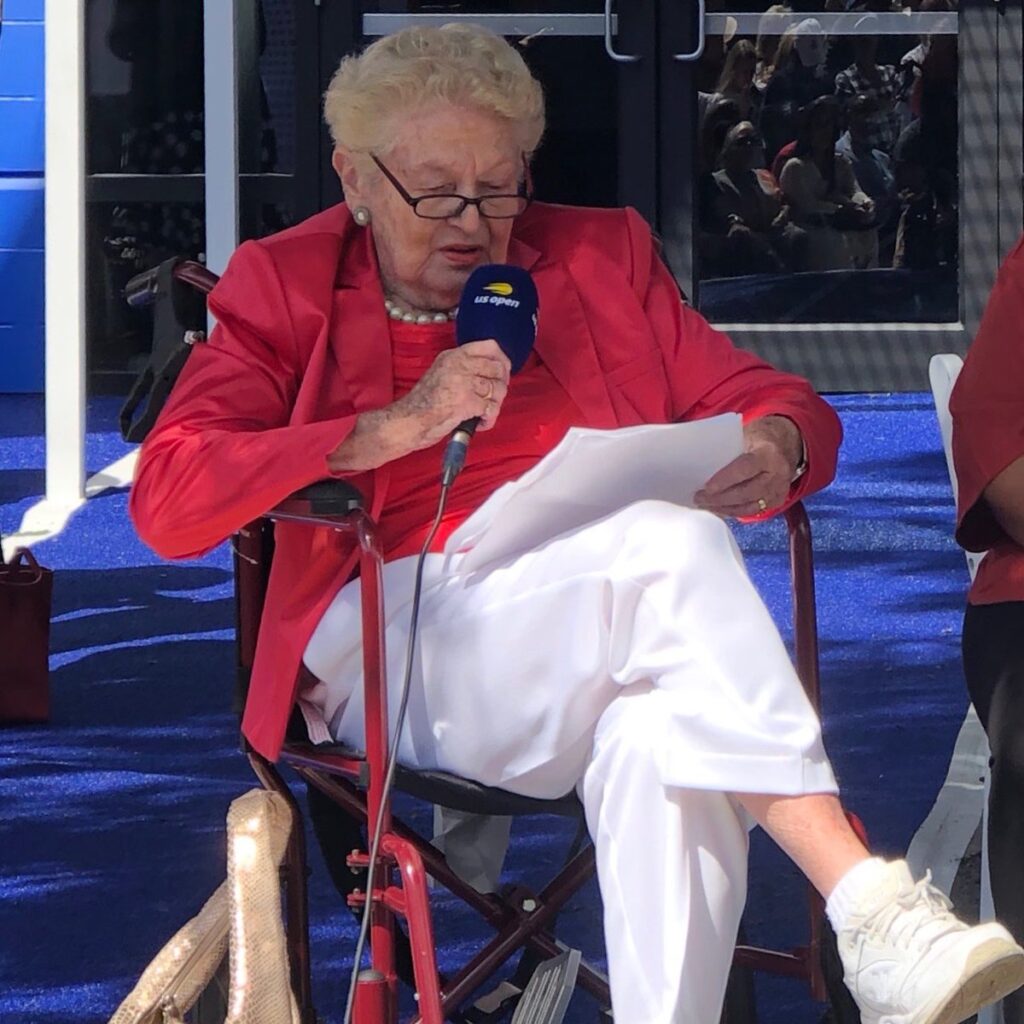
Angela Buxton reading remarks at the unveiling of the statue of Althea Gibson at Flushing Meadows during the 2019 U.S. Open.
Other Jewish players, including American Wimbledon champion Dick Savitt, have become members, and there is some confusion surrounding Buxton’s application to the club. Still, the fact that a Jewish woman who did more than practically anyone else to support the integration of tennis and the recognition of Black tennis players, especially women, remains a serious oversight, according to many historians. “Not inviting Angela Buxton to become a member of the All England Club in 1956 was a startling omission by the Club,” said David Berry, the author of A People’s History of Tennis. “It was true that only singles champions are automatically given honorary membership of the Club. But that year Angela had won the doubles… and lost in the singles final to Althea. This was the best achievement by a British woman for many decades and surely merited being offered membership.”
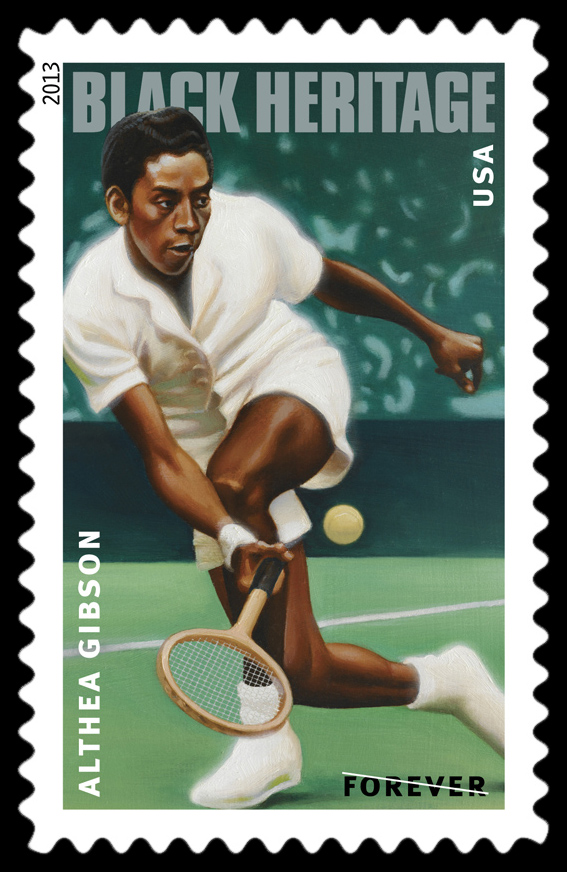
A U.S. Postal Service stamp honouring Althea Gibson, the 36th stamp in the Black Heritage series of U. S. commemorative stamps.
Angela Buxton, born in Liverpool in 1934 to Violet (Greenberg) Buxton and Harry Buxton, a nascent entertainment mogul, spent her formative years (1940-1945) in Cape Town and then, Johannesburg, South Africa, where she was often reprimanded for playing with the children of Black servants — colour barriers had never crossed her mind, she once said. When the war ended in 1945 and the Buxtons returned to England, they settled in Hampstead, where Buxton trained under Bill Blake at the Cumberland Club, the best club in North London. Angela felt she was a shoo-in for membership. “(Bill) welcomed this young player who seemed to have some promise, and after a few lessons, gave her an application to join the club,” according to author Bruce Schoenfeld. “She filled it out: name, address, parents’ name, religion, all the details. Weeks passed and nobody mentioned her status…
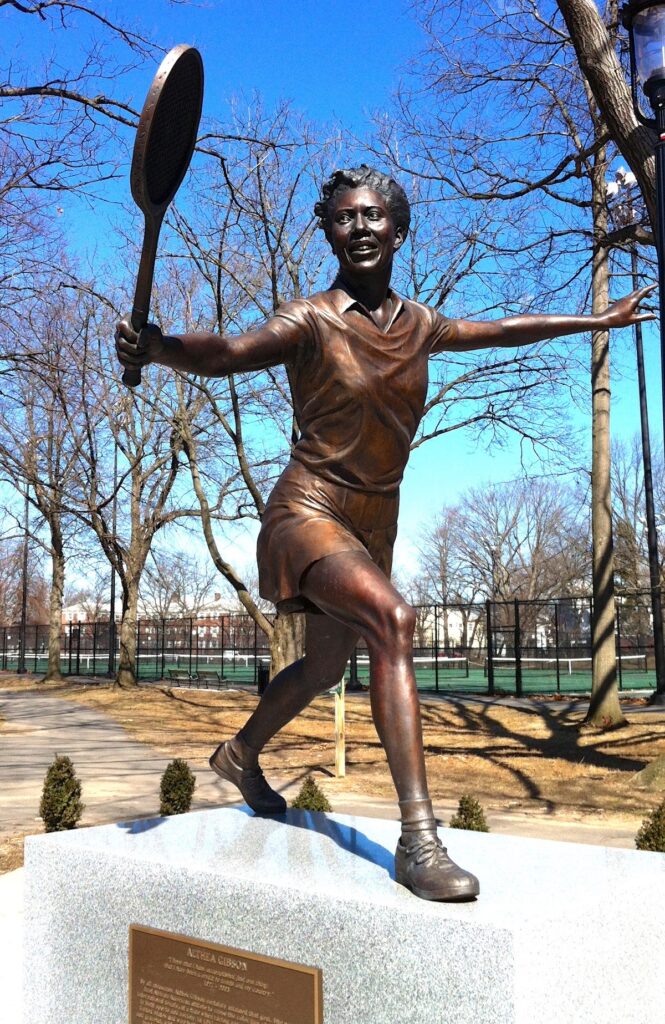
A life-size bronze of Althea Gibson created by Jay Warren unveiled at the Althea Gibson Tennis Center in Branch Brook Park, Newark, New Jersey.
“Each time she stepped inside the club… she inquired about the application… Finally, Bill Blake couldn’t stand it any longer. ‘Look, Angela, please don’t keep asking me, you’re not going to be able to join the club,’ Blake told her.” When she asked why not, he replied, “‘No, you’re perfectly good, but you’re Jewish.’” That was the first time Buxton felt prejudice in her home country.
Friends and colleagues of Buxton said she could be “difficult,” sometimes “code” for anti-Semitism, according to Berry. But many alluded to her being headstrong. “Angela Buxton divided people,” Berry wrote. “She… did not go out of her way to make friends or be charming to tennis authorities.
“Norman Dale, a county player at the time and Jewish himself, remembered her as ‘simply not popular. She was very, very serious and dedicated to her tennis. People did not like that in those days.’”
Some people didn’t like it. But in their dedication, Gibson and Buxton were soul sisters. As soon as Buxton saw Gibson during Gibson’s 1951 British debut at The Queen’s Club, she knew she had seen the future. “The British weren’t particularly taken with Althea, either,” Schoenfeld wrote, “she seemed arrogant in her conversations with other players, tight-lipped and… quick to take offense.”
The truth is, in the early 1950s, Gibson had hit a slump. Although she had started promisingly and swept the American Tennis Association (ATA) Championships (the Black players’ USTA), followed by her first Forest Hills appearance in 1951, Gibson almost gave up tennis to join the Women’s Auxiliary Army. But a U.S. goodwill tour of Southeast Asia and an acquaintance with Buxton changed the course of history. Buxton, who was there for the Wightman Cup, an annual US vs. UK women’s team tennis competition, began practicing with Gibson and before the trip was through “Angela had convinced Althea to travel to Europe.”

Buxton hits a forehand volley at a club in England during the height of her career in the 1950s.
From then, until Buxton’s retirement in 1956 due to tenosynovitis, an incurable wrist inflammation, and Gibson’s in 1958, the two were not only doubles champions and practice partners, but moral supports, cinema buddies, golfing mates and in the case of Buxton, occasional patron. Whenever Gibson came to play in England, she stayed at Rossmore Court (Buxton’s apartment near Regents Park), and Buxton, a designer for Lillywhite’s sporting goods store, helped dress Gibson for her subsequent grass court appearances at Queen’s, in Bournemouth and during her 1958 Wimbledon championship.
In their later lives, Buxton went on to marry Donald Silk, a Zionist lawyer who put the nascent Israeli state above all else, including their three children, Benjamin, Joseph and Rebecca. After leaving him in the 1960s, Buxton formed the Angela Buxton Tennis Academy in North London with her former coach, Clarence Medleycott “Jimmy” Jones, a newspaperman, tennis magazine founder and until the end of his life, companion. After Jones and her son, Joseph died of HIV, she permanently moved to Florida, continued her coaching, while also sponsoring young players competing at America’s Orange Bowl.
Gibson, on the other hand, wasn’t ready to give up sports, or the limelight. After a brief singing career — as well as an appearance on the Ed Sullivan Show — Gibson joined the Ladies Professional Golf Association (LPGA) and integrated golf. Despite a sponsorship with the Harry C. Lee sporting goods company, a tour with the Harlem Globetrotters with former amateur Karol Fageros (Gibson v. Fageros were the opening act) and positions teaching tennis, however, Gibson was never able to consistently “rub two nickels together,” Buxton said. There were several reasons for this, according to Schoenfeld. Gibson and Buxton came of age as players before the Open era, when amateurs still competed for nothing and women for even less. Gibson also had nothing to fall back on, unlike Buxton who came from wealth. Lastly, Gibson dated several men, and later married a former coach who spent her funds lavishly, seemingly as “ a means to reward (Sidney) Llewellyn for his years of assistance.”
Yet for Gibson, the honours were manifest. In addition to the honorary membership to the AELTC, the ITHF, the (U.S.) National Women’s Hall of Fame, the Theodore Roosevelt Award, the highest honour from the National Collegiate Athletic Association, induction into the US Open Court of Champions, a foundation in her honour, the Althea Gibson Foundation, which supports gifted golf and tennis players, the display of her five Wimbledon trophies at the Smithsonian Institution’s National Museum of American History, a bronze statue, created by sculptor Thomas Jay Warren, in Branch Brook Park (Newark, New Jersey), a United States Postal Service stamp and lastly, a statue honouring Gibson at the U.S. Open — only the second Flushing Meadows monument erected for a champion. Buxton attended the unveiling in 2019 at age 85. “We won both the French and Wimbledon doubles together with my arm around her both times at the closing ceremonies,” Buxton said during the ceremony. “She slowly became the Jackie Robinson of tennis…”
In the scattered months following her 1956 Wimbledon accomplishments, Angela had been advised to “strike while the iron is hot,” for Wimbledon membership because “you may never get the chance again,” Buxton told Schoenfeld. While singles winners automatically become members — and still do to this day — winners of the Gentlemen’s Ladies’ and Mixed Doubles must submit applications. Angela did as told, but never received a response. She thought about it occasionally through the years, according to The Match, but she wasn’t planning on taking a journey to SW19 just to play tennis. But her lack of membership started to resonate among her pupils and peers. In 2019, a reporter from the Times came to inquire about it, and she willingly told him, “I suppose it’s because I’m Jewish,” which made headlines. Wimbledon had a few Jewish members by then, but none as forthright or as prominent as Buxton. In time, the AELTC informed Buxton that she must have declined and that she would have to return to the waiting list. “That’s all right, I’ve only been waiting thirty years,” Buxton said. Buxton died in Fort Lauderdale, Florida in August 2020.

A statue of Althea Gibson on the opening day of the 2019 U.S. Open. Comprised of five granite blocks and created by American sculptor Eric Goulder, the statue sits outside Arthur Ashe Stadium at the Billie Jean King National Tennis Center in Queens, New York.
“A couple of years ago, a ‘friend’ of the All England Club invited me to an off the record briefing about the ‘real reason’ Angela was never offered membership hinting at some aspects of her character that were not in keeping with the club,” Berry said. “Certainly, she could be a difficult woman at times — but then so could many other top champions. I declined the briefing on the basis that it is too easy to make character aspersions without anyone taking responsibility for them.
“Now of course we will never know unless the All England Club finally decides to talk about the matter openly, about as likely as a British woman in this year’s Wimbledon championships coming anywhere near emulating Angela’s amazing achievement in 1956.”
Perhaps it bothered Buxton to the very end, perhaps not. In her later years, she was almost totally focused on the new generation of players. When in 1996, Buxton received an invitation from Richard Williams to meet his young daughter, Venus, Buxton asked for a phone and punched in Gibson’s numbers and the two Black trailblazers chatted. Eight months later, on the Eve of Venus’ run to the U.S. Open final, Gibson gave to Venus the same advice she had lived by and passed on to her lifelong doubles partner. “Be who you are and let your racquet do the talking,” she said. “The crowd will love you.”

